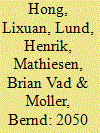|
|
|
Sort Order |
|
|
|
Items / Page
|
|
|
|
|
|
|
| Srl | Item |
| 1 |
ID:
117326


|
|
|
|
|
| Publication |
2013.
|
| Summary/Abstract |
In 2009, Jiangsu province of China supplied 99.6 percent of its total energy consumption with fossil fuels, of which 82 percent was imported from other provinces and countries. With rising energy demand, frequent energy shortages, and increasing pollution, it is essential for Jiangsu to put more emphasis on improving its energy efficiency and utilizing its renewable resources in the future. This paper presents the integrated energy pathway for Jiangsu during its social and economic transformation until 2050. EnergyPLAN is the chosen energy system analysis tool, since it accounts for all sectors of the energy system that needs to be considered when integrating large-scale renewable energy. A current policy scenario (CPS) based on current energy policies and an ambitious policy scenario (APS) based on large-scale integration of renewable energy and ambitious measures of energy efficiency improvement are proposed. The two energy pathways are modeled and compared in terms of technology combination, non-fossil fuel shares of primary energy supply, socioeconomic costs, and CO2 emissions. The insights from these pathways can provide valuable input for Jiangsu's future energy policies.
|
|
|
|
|
|
|
|
|
|
|
|
|
|
|
|
| 2 |
ID:
103401


|
|
|
|
|
| Publication |
2011.
|
| Summary/Abstract |
Denmark's future energy system is to be entirely based on renewable energy sources. Municipalities will play an important role as local energy planning authorities in terms of adopting and refining this vision in different local contexts. Based on a review of 11 municipal energy plans, this paper examines to what extent municipal energy planning matches national 100% renewable energy strategies. The results indicate a willingness among Danish municipalities to actively carry out energy planning, and the plans reveal a large diversity of (new) activities. At the same time, however, there is a strong need for better coordination of municipal energy planning activities at the central level. It is suggested that the role of municipalities as energy planning authorities needs to be outlined more clearly in, e.g., strategic energy planning which integrates savings, efficiency and renewable energy in all (energy) sectors. This requires the state to provide municipalities with the necessary planning instruments and establish a corresponding planning framework. Consequently, there is a need for a simultaneous centralisation and decentralisation during the implementation of the 100% renewable energy vision. The paper outlines a basic division of tasks between the central and the local level within such a strategic energy planning system.
|
|
|
|
|
|
|
|
|
|
|
|
|
|
|
|
| 3 |
ID:
122744


|
|
|
|
|
| Publication |
2013.
|
| Summary/Abstract |
Transport is one of the most challenge sectors when addressing energy security and climate change due to its high reliance on oil products and lack of the alternative fuels. This paper explores the ability of three transport strategies to contribute to the development of a sustainable transport in China. With this purpose in mind, a Chinese transport model has been created and three current transport strategies which are high speed railway (HSR), urban rail transit (URT) and electric vehicle (EV) were evaluated together with a reference transport system in 2020. As conservative results, 13% of the energy saving and 12% of the CO2 emission reduction can be attained by accomplishing three strategies compared with the reference transport system. However, the energy demand of transport in 2020 with the implementation of three strategies will be about 1.7 times as much as today. The three strategies show the potential of drawing the transport demand to the more energy efficient vehicles; however, more initiatives are needed if the sustainable transport is the long term objective, such as the solutions to stabilise the private vehicle demands, to continuously improve the vehicle efficiency and to boost the alternative fuels produced from the renewable energy sources.
|
|
|
|
|
|
|
|
|
|
|
|
|
|
|
|
|
|
|
|
|